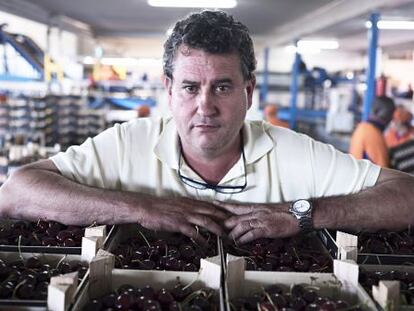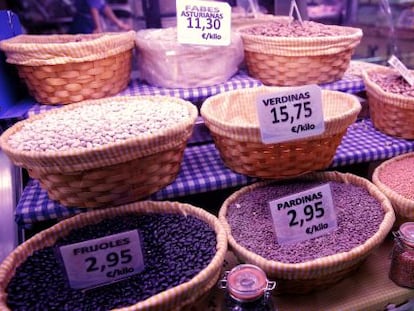If it’s a cucumber, it’s probably Spanish
Spain’s fruit and vegetables are among the most sought-after in Europe


If you're in Madrid and going to make a refreshing summer salad, with say tomato, lettuce and onion, followed by baked apple for desert, the chances are the lettuce will be Spanish, the tomato Italian, the onion Dutch, and the apple Polish. If you throw in a potato for good measure, and you can be pretty sure it's going to be German, at least according to the latest data from the EU's statistics office, Eurostat.
Spain is also an EU leader in the production of cauliflower, broccoli and peppers (contributing 42%), along with garlic
The EU dedicates 2.3 million hectares to cultivating fruit, and another 2.1 million hectares set aside for growing vegetables. Of the land used for growing fruit, 27.1% is in Spain; while 20% of vegetables are grown in Italy.
Furthermore, Spain harvests one in three of Europe’s peaches, while Italy provides another third, with Greece contributing 23.2%. Spain also leads in the production of strawberries, growing 29% of Europe’s total. When it comes to cherries, however, the country's famed Jerte Valley in Caceres province produces just 10.7% of the total, or 94,000 tons, while Poland produces more than twice as much as Italy's 110,000 tons.
Unsuprisingly, one of the stars of the European fruit market is the apple. Each year as many as 12.7 million tons of apples are harvested in Europe, equivalent to 25 kilograms per capita. The EU's grape harvest is even bigger, but almost 9 out of 10 bunches are pressed for wine. The next most abundant fruit is the orange, with 6.3 million tons harvested in Europe in 2014, 46% of which were Spanish, with Poland next (also a leader in apple production), then Italy and France.
The king of the vegetable patch
If the apple is queen of the orchard, the tomato is king of the vegetables. As much as 35 kg of tomatoes are picked annually per capita, making it the most bountiful product in Europe’s collective vegetable garden. Italy leads here with 36.3% of European tomato production, with Spain accounting for 27.4% and Portugal 8%.
Sign up for our newsletter
EL PAÍS English Edition has launched a weekly newsletter. Sign up today to receive a selection of our best stories in your inbox every Saturday morning. For full details about how to subscribe, click here
Not to be outdone, the Netherlands has recently become a big tomato producer, and is now in 5th place in Europe. But when it comes to cucumbers, Spain is the champion grower, with 29.1% of the 2.3 million tons produced in the EU overall. Spain is also the biggest producer of zucchini, with 37.6% of the total EU haul.
The United Kingdom is a prime carrot producer, accounting for 14.2% of total EU output, while, as said, most lettuces eaten from Warsaw to Lisbon are Spanish, some 38%. Spain is also a leader in the production of cauliflower, broccoli and peppers (contributing 42%), along with garlic, but the Netherlands pips it to the post with its onion output. King of the kartoffel, Germany dominates tops potato production with 10.3 million tons of the total 52.8 tons produced in Europe. The Netherlands and Poland are next with 6.6 and 6.1 million tons respectively.
English version by Heather Galloway.
Tu suscripción se está usando en otro dispositivo
¿Quieres añadir otro usuario a tu suscripción?
Si continúas leyendo en este dispositivo, no se podrá leer en el otro.
FlechaTu suscripción se está usando en otro dispositivo y solo puedes acceder a EL PAÍS desde un dispositivo a la vez.
Si quieres compartir tu cuenta, cambia tu suscripción a la modalidad Premium, así podrás añadir otro usuario. Cada uno accederá con su propia cuenta de email, lo que os permitirá personalizar vuestra experiencia en EL PAÍS.
¿Tienes una suscripción de empresa? Accede aquí para contratar más cuentas.
En el caso de no saber quién está usando tu cuenta, te recomendamos cambiar tu contraseña aquí.
Si decides continuar compartiendo tu cuenta, este mensaje se mostrará en tu dispositivo y en el de la otra persona que está usando tu cuenta de forma indefinida, afectando a tu experiencia de lectura. Puedes consultar aquí los términos y condiciones de la suscripción digital.
More information
Últimas noticias
Welcome to the post-religion era: The idea of Christianity as the absolute truth has become obsolete
‘I thought you would like it’: The risky sexual practice popularized by TV shows and TikTok
The digitalization of tourism: ‘They promise experiences and gave us the worst possible one’
Mexican peso defies uncertainty with forecasts of a new period of stability in 2026
Most viewed
- Sinaloa Cartel war is taking its toll on Los Chapitos
- Reinhard Genzel, Nobel laureate in physics: ‘One-minute videos will never give you the truth’
- Oona Chaplin: ‘I told James Cameron that I was living in a treehouse and starting a permaculture project with a friend’
- Why the price of coffee has skyrocketed: from Brazilian plantations to specialty coffee houses
- Silver prices are going crazy: This is what’s fueling the rally










































